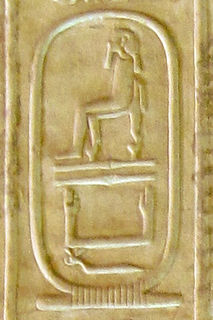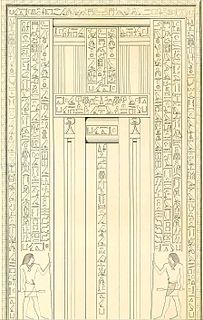Related Research Articles

Sahure was a pharaoh of ancient Egypt and the second ruler of the Fifth Dynasty. He reigned for about 12 years in the early 25th century BC during the Old Kingdom Period. Sahure's reign marks the political and cultural high point of the Fifth Dynasty. He was probably the son of his predecessor Userkaf with Queen Neferhetepes II, and was in turn succeeded by his son Neferirkare Kakai.

Hetepheres II was a Queen of Ancient Egypt during the 4th Dynasty.

Huni was an ancient Egyptian king and the last pharaoh of the Third Dynasty of Egypt during the Old Kingdom period. Following the Turin king list, he is commonly credited with a reign of 24 years, ending c. 2613 BC.

Shepseskaf was the sixth and last pharaoh of the Fourth Dynasty of Egypt during the Old Kingdom. He reigned six to eight years starting circa 2510 BC. The only activities firmly datable to his reign are the completion of the temple complex of the Pyramid of Menkaure and the construction of its own mastaba tomb at South Saqqara, the Mastabat al-Fir’aun, "stone bench of the pharaoh".

Userkaf was a pharaoh of ancient Egypt and the founder of the Fifth Dynasty. He reigned for seven to eight years in the early 25th century BC, during the Old Kingdom period. He probably belonged to a branch of the Fourth Dynasty royal family, although his parentage is uncertain; he could have been the son of Khentkaus I. He had at least one daughter and very probably a son, Sahure, with his consort Neferhetepes. This son succeeded him as pharaoh.

Neferirkare Kakai was an ancient Egyptian pharaoh, the third king of the Fifth Dynasty. Neferirkare, the eldest son of Sahure with his consort Meretnebty, was known as Ranefer A before he came to the throne. He acceded the day after his father's death and reigned for eight to eleven years, sometime in the early to mid-25th century BCE. He was himself very likely succeeded by his eldest son, born of his queen Khentkaus II, the prince Ranefer B who would take the throne as king Neferefre. Neferirkare fathered another pharaoh, Nyuserre Ini, who took the throne after Neferefre's short reign and the brief rule of the poorly known Shepseskare.

Neferefre Isi was an ancient Egyptian pharaoh of the Fifth Dynasty during the Old Kingdom period. He was most likely the eldest son of pharaoh Neferirkare Kakai and queen Khentkaus II. He was known as prince Ranefer before he ascended to the throne.

Nyuserre Ini was an Ancient Egyptian pharaoh, the sixth ruler of the Fifth Dynasty during the Old Kingdom period. He is credited with a reign of 24 to 35 years depending on the scholar, and likely lived in the second half of the 25th century BCE. Nyuserre was the younger son of Neferirkare Kakai and queen Khentkaus II, and the brother of the short-lived king Neferefre. He may have succeeded his brother directly, as indicated by much later historical sources. Alternatively, Shepseskare may have reigned between the two as advocated by Miroslav Verner, albeit only for a few weeks or months at the most. The relation of Shepseskare with Neferefre and Nyuserre remains highly uncertain. Nyuserre was in turn succeeded by Menkauhor Kaiu, who could have been his nephew and a son of Neferefre.

Shepseskare or Shepseskara was an Ancient Egyptian pharaoh, the fourth or fifth ruler of the Fifth Dynasty during the Old Kingdom period. Shepseskare lived in the mid-25th century BC and was probably the owner of an unfinished pyramid in Abusir, which was abandoned after a few weeks of work in the earliest stages of its construction.

Abusir is the name given to an Egyptian archaeological locality – specifically, an extensive necropolis of the Old Kingdom period, together with later additions – in the vicinity of the modern capital Cairo. The name is also that of a neighbouring village in the Nile Valley, whence the site takes its name. Abusir is located several kilometres north of Saqqara and, like it, served as one of the main elite cemeteries for the ancient Egyptian capital city of Memphis. Several other villages in northern and southern Egypt are named Abusir or Busiri. Abusir is one relatively small segment of the extensive "pyramid field" that extends from north of Giza to below Saqqara. The locality of Abusir took its turn as the focus of the prestigious western burial rites operating out of the then-capital of Memphis during the Old Kingdom 5th Dynasty. As an elite cemetery, neighbouring Giza had by then "filled up" with the massive pyramids and other monuments of the 4th Dynasty, leading the 5th Dynasty pharaohs to seek sites elsewhere for their own funerary monuments.

The Pyramid of Neferirkare was built for the Fifth Dynasty pharaoh Neferirkare Kakai in the 25th century BC. It was the tallest structure on the highest site at the necropolis of Abusir, found between Giza and Saqqara, and still towers over the necropolis. The pyramid is also significant because its excavation led to the discovery of the Abusir Papyri.

Prince Ankhhaf was an Egyptian prince and served as vizier and overseer of works to the Pharaoh Khufu, who was Ankhhaf's half-brother. He lived during Egypt's 4th Dynasty.

The Pyramid of Sahure is a late-26th-to-25th century BC pyramid complex built for the Egyptian pharaoh Sahure of the Fifth Dynasty. Sahure built the inaugural pyramid in Abusir after his direct predecessor, Userkaf, built his sun temple in the same area. Sahure's successors, Neferirkare Kakai, Neferefre, and Nyuserre Ini all built their monuments in the vicinity. The site was first properly excavated by Ludwig Borchardt between March 1907 and 1908, who penned the seminal work on the topic Das Grabdenkmal des Königs Sahu-Re between 1910 and 1913.

The Pyramid of Neferefre, also known as the Pyramid of Raneferef, is a 25th century BC unfinished pyramid complex built for the Egyptian pharaoh Neferefre of the Fifth Dynasty. Neferefre's unfinished pyramid is the third and final one built on the Abusir diagonal – a figurative line connecting the Abusir pyramids with Heliopolis – of the necropolis, sited south-west of Neferirkare's pyramid.
Kaemsekhem was an ancient Egyptian nobleman and probably the son of Crown Prince Kawab and Hetepheres II. He later served as the director of the royal palace. He was buried in mastaba G 7660 in the Giza East Field, which is part of the Giza Necropolis.

Khentkaus I, also referred to as Khentkawes, was a royal woman who lived in ancient Egypt during both the Fourth Dynasty and the Fifth Dynasty. She may have been a daughter of king Menkaure, the wife of both king Shepseskaf and king Userkaf, the mother of king Sahure. Some suggest that she was the regent for one of her sons. Perhaps, in her own right, she may have been the king of Upper and Lower Egypt, which aspects of her burial suggests. Her mastaba at Giza – tomb LG100 – is located very close to Menkaure's pyramid complex. This close connection may point to a family relationship. Although the relationship is not clear, the proximity of the pyramid complex of Khentkaus to that of king Menkaure has led to the conjecture that she may have been his daughter.
Hemetre (Hemetra) was an ancient Egyptian royal woman of the Fourth Dynasty. Hemetre may have been a daughter or granddaughter of Khafre. She did not hold the title king's wife and may have even married a non-royal. She is mainly known from her tomb, which is located in the central field of Giza. Her name honors the god Ra.

Seshemnefer was an ancient Egyptian official of the Fifth Dynasty, most likely under king Djedkare Isesi. At the end of his career he became vizier, the highest office in Ancient Egypt, second only to the king.

Pehenuikai was an Ancient Egyptian official of the Fifth Dynasty. His main office was that of a vizier, making him to the most important man at the royal court, only second to the king. Beside being vizier, he was also holding many other important titles, such as Overseer of the treasuries, overseer of the scribes of the king's document, overseer of the double granary and overseer of all royal works of the king.

The Pyramid of Nyuserre is a mid-25th-century BC pyramid complex built for the Egyptian pharaoh Nyuserre Ini of the Fifth Dynasty. During his reign, Nyuserre had the unfinished monuments of his father, Neferirkare Kakai, mother, Khentkaus II, and brother, Neferefre, completed, before commencing work on his personal pyramid complex. He chose a site in the Abusir necropolis between the complexes of Neferirkare and Sahure, which, restrictive in area and terrain, economized the costs of labour and material. Nyuserre was the last king to be entombed in the necropolis; his successors chose to be buried elsewhere. His monument encompasses a main pyramid, a mortuary temple, a valley temple on Abusir Lake, a causeway originally intended for Neferirkare's monument, and a cult pyramid.
References
- ↑ Hassan 1932, pp. 1-60.
- ↑ Hassan 1932, pp. 2-3.
- ↑ Allen 1992, pp. 14-20.
- ↑ Borchardt 1913, pp. 119.
- ↑ Hassan 1932, pp. 3.